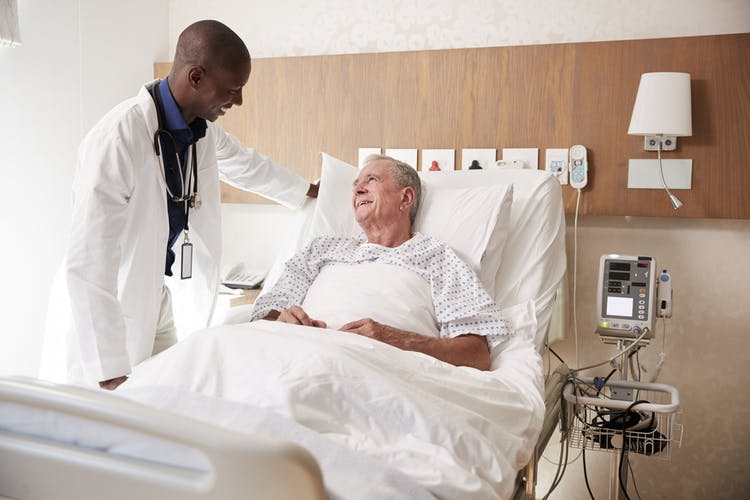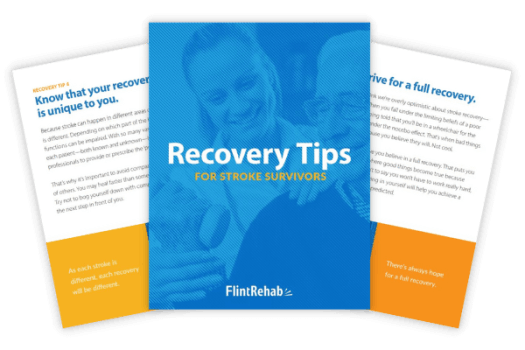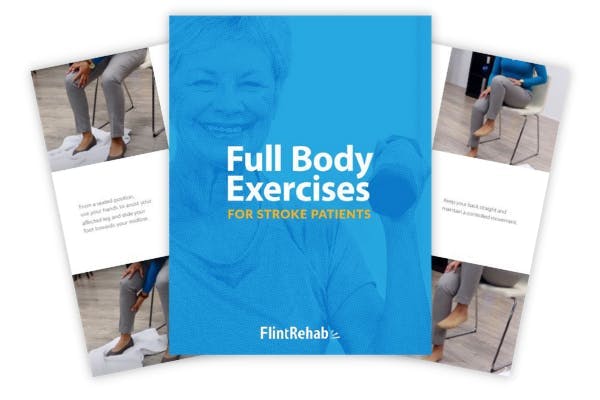No products in the cart.
No products in the cart.
No products in the cart.
No products in the cart.
Home » Neurological Recovery Blog » Stroke » Bedridden After Stroke: How Survivors Can Maximize Recovery
Last updated on September 28, 2023

A stroke is a major neurological injury, and some survivors will have the experience of being bedridden after stroke. While this term may sound extreme, this can have a major impact on a survivor’s health, independence, and quality of life. Remaining in bed for an extended period can lead to additional complications and make daily life difficult for both the survivor and their caregiver.
Thankfully, there are steps you can take to help manage potential complications and maximize your chances of recovering function. Prioritizing exercise and frequent movement are the foundation of recovery for survivors who are bedridden after stroke. In this article, we will discuss the different reasons a survivor may lack active movement as well as steps you can take toward rehabilitation.
Feel free to use these jump links to help you navigate this article:
The secondary effects of stroke depend largely on the area of the brain affected as well as the severity of the stroke. Depending on these factors, survivors commonly experience hemiplegia or hemiparesis, which refers to paralysis or weakness of one half of the body. This is often the culprit behind a survivor’s bedridden status because this can make movement extremely difficult.
Paralysis, or hemiplegia, can occur after a stroke has damaged the areas of the brain responsible for movement, such as the motor cortex. Normally, the brain and muscles are constantly communicating with each other to create movement. However, when this communication is disrupted by stroke, the resulting motor and sensory difficulties make it difficult to sit, stand, or walk.
In addition to hemiplegia and hemiparesis, many other stroke-related complications or events can take place. Some survivors may be in a coma for some time after the stroke while others may be malnourished due to dysphagia, or difficulty swallowing. These, as well as other secondary illnesses, can lead to progressive weakness and muscle loss. This can further complicate recovery and contribute to a survivor’s nonmobile status.
Before we dive into the steps you can take to improve mobility, let’s discuss what complications can happen if a survivor remains nonmobile. These complications can affect many functions and areas of the body, so it can help to make yourself aware of what things you should watch for. To start, here are some common complications that can occur when someone is bedridden:
All these complications have something in common: they can be improved through movement. This is the reason why participating in therapy is so incredibly important after stroke. In the next section, we will discuss how survivors can improve their motor function with rehab.
Movement is the key to maintaining the well-being of a stroke survivor who is bedridden. This is because of the brain’s ability to heal after stroke through the process of neuroplasticity. Neuroplasticity is at the core of stroke recovery. When a stroke damages brain tissue and functions are lost, neuroplasticity allows other areas of the brain to take on those functions.
Therefore, consistent exercise is the key to recovery, including recovery from severe motor disorders such as post-stroke paralysis. When you move your body through exercises, you help stimulate the brain. This allows your brain to adapt its neural circuitry to the tasks that you regularly perform.
To maximize neuroplasticity, it is important to perform high repetition of therapy exercises. This high repetition can sometimes be referred to as massed practice. Movement not only helps improve potential complications such as learned nonuse, but it also maximizes chances of motor recovery. Therefore, performing the exercises provided to you by your therapy team is one of the best ways to improve your mobility after stroke.
Work closely with your physical, occupational, and speech therapists to create a program that helps you meet your unique goals. They can incorporate your favorite activities to help you stay motivated to perform your exercises. In the next section, we will review the different types of exercises your therapists may recommend for your rehab program.
We know that exercise is necessary for all stroke survivors, including those who are bedridden. However, it can be overwhelming to think about all the different kinds of exercise available. To help you better understand, let’s review the different kinds of exercise you may utilize to restore movement after stroke:
Mental practice is an accessible form of therapy for all nonmobile stroke survivors, and it should not be overlooked due to its simple nature. To perform mental practice, survivors should visualize themselves performing the motion they would like to achieve. This can help encourage neuroplasticity and the effects can be powerful when performed consistently.
To boost neuroplasticity and see the greatest results, studies have shown that mental practice is most effective when combined with physical practice. For example, mental practice can be combined with passive range of motion exercises, which we will discuss
Passive exercise involves assisting your affected side to move through its full range of motion. Ideally, you would use your non-affected side to accomplish this. However, some bedridden stroke survivors cannot achieve this type of movement yet and may need the help of a therapist or caregiver.
Even if a caregiver is making the movements for you, this still helps activate neuroplasticity. In time, passive exercise may help restore movement, especially when combined with mental practice. Studies have shown that passive movement helps activate neuroplasticity and facilitate motor recovery even though your muscles are not actively contracting. As you progress and become stronger, you may be able to transition from passive exercises to active exercises.
As you become stronger, your therapist may be able to help you progress to active exercises. Active exercises are exercises that require active muscle contraction. This means you are performing the exercises with your own muscle strength, although you may still require some assistance at first. These exercises can be performed lying down, sitting, and even standing as you become stronger.
Your therapy team will help you create a program that addresses your specific secondary effects. This can include exercises for leg strengthening, increasing balance, and improving shoulder function. As you get stronger, you can improve your mobility and spend less time in bed. To motivate yourself, be sure to read about Ron, a stroke survivor who recovered from paralysis by doing highly repetitive exercises consistently.
Due to the uncertain outcomes of stroke, many people find themselves wondering what the recovery outlook is for survivors who are nonmobile. While being bedridden is a predictor of mortality, there are many other factors to consider on a case-by-case basis.
For example, one study on the long-term outlook of stroke found that bedridden patients lived for about 4-6 months after their stroke. However, the study only included individuals who were over 80 years old and did not consider other risk factors. These factors include pre-stroke disability, comorbidities such as diabetes, and other vascular risk factors.
A large systematic review found that around 15% of survivors with paralysis experienced a complete recovery of upper and lower limb function. Additionally, 65% of survivors experienced some return of leg function. The fastest improvements in function are generally seen in the first 3-6 months after stroke due to spontaneous recovery, although improvement is always feasible.
It’s important to know that every stroke is different and therefore, every recovery is different. No one can say with certainty if a person can or can’t recover. What we do know is that recovery is possible, even years after stroke. The best results are seen when patients are motivated to improve and diligently pursue recovery long-term.
Ultimately, the outcome of any given stroke is unknown, and while this can be uncomfortable for family members of nonmobile survivors, it also holds room for hope. Take stroke survivor Becky, for example. After her stroke, she was bedridden due to locked-in syndrome, which is a condition where she could not move anything but her eyes. However, she regained movement and is improving over eleven years later.
If you or your loved one is currently nonmobile, there’s a lot that you can do to help. Work closely with your therapy team to create a rehab program that meets your specific needs. They can help train caregivers on how to perform passive range of motion exercises to increase a survivor’s mobility. Furthermore, your therapists will provide you with tips to avoid developing complications such as contractures or bed sores.
All movement is beneficial. In addition to preventing complications, exercise encourages healing in the brain and the rewiring of lost functions. Try including mental practice during your passive rehab exercises for maximum benefit. With time, some survivors can regain strength and increase mobility and independence.
There are many stroke recovery stories that show there’s always hope, even for survivors with limited mobility. Staying consistent with the practice of therapy exercises will allow you to make the greatest recovery. We hope this article has provided motivation to continue pursuing rehabilitation and to remain dedicated to your recovery program.

Get our free stroke recovery ebook by signing up below! It contains 15 tips every stroke survivor and caregiver must know. You’ll also receive our weekly Monday newsletter that contains 5 articles on stroke recovery. We will never sell your email address, and we never spam. That we promise.


Do you have these 25 pages of rehab exercises?
Get a free copy of our ebook Full Body Exercises for Stroke Patients. Click here to get instant access.
“My name is Monica Davis but the person who is using the FitMi is my husband, Jerry. I first came across FitMi on Facebook. I pondered it for nearly a year. In that time, he had PT, OT and Speech therapy, as well as vision therapy.
I got a little more serious about ordering the FitMi when that all ended 7 months after his stroke. I wish I hadn’t waited to order it. He enjoys it and it is quite a workout!
He loves it when he levels up and gets WOO HOOs! It is a wonderful product! His stroke has affected his left side. Quick medical attention, therapy and FitMi have helped him tremendously!”
FitMi is like your own personal therapist encouraging you to accomplish the high repetition of exercise needed to improve.
When you beat your high score or unlock a new exercise, FitMi provides a little “woo hoo!” as auditory feedback. It’s oddly satisfying and helps motivate you to keep up the great work.
In Jerry’s photo below, you can see him with the FitMi pucks below his feet for one of the leg exercises:
Many therapists recommend using FitMi at home between outpatient therapy visits and they are amazed by how much faster patients improve when using it.
It’s no surprise why over 14,000 OTs voted for FitMi as “Best of Show” at the annual AOTA conference; and why the #1 rehabilitation hospital in America, Shirley Ryan Ability Lab, uses FitMi with their patients.
This award-winning home therapy device is the perfect way to continue recovery from home. Read more stories and reviews by clicking the button below:
Grab a free rehab exercise ebook!
Sign up to receive a free PDF ebook with recovery exercises for stroke, traumatic brain injury, or spinal cord injury below: